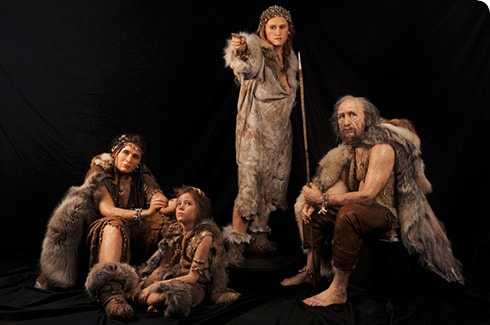Fashion Industry History
The history of fashion pre-dates the history of the fashion industry. Yes, this is a, “who came first the chicken or the egg” scenario. Fortunately, in the case of determining the origin of the garment industry the answer is more clear. Clothing existed before the industry.

Image Source: Natural History Museum (London)
The fashion industry was created to design, market, manufacture, and sell clothes, footwear, and accessories.
Prior to the creation of the apparel industry, people created clothes for themselves. As the world evolved, the industry was formulated to manage the process for consumers. The mass production of clothing began roughly in the mid-nineteenth century, when some manufacturers began to produce garments that did not require fitting session with the sewer or tailors. Fashion did not become an established industry in the institution sense of the word until the twentieth century, when networks of neighborhood tailors casually evolved into manufacturing businesses. Factories grew from necessity during the world war 1 & 2 era. The ensuing social and cultural changes of the time period signified the dawn of less restrictive and unilateral codes of dress. Changes in the business of fashion, and the establishment of designers as arbiters of taste, began to take shape in the early part of the century, although largely led by European fashion houses.
In the 1950s and 1960s, a growing number of entrepreneurial designers began to make their way out of the backrooms to feature their own names on their labels (creation of designer brand names), a development facilitated in part by the curiosity of the press and also by the ambitions of manufacturers to capitalize on designer personalities.
Licensing a designer name into other categories became a common practice, and by the 1980s. During this time period, several fashion designers had become celebrities in their own right. You are most likely familiar with many of the designer brands that were led by ambitious and charismatic personalities. To name a few, Oscar de la Renta, Ralph Lauren, Bill Blass, Calvin Klein, and Halston.
The fashion industry of the early 2000s is global for certain. Luxury conglomerates have been taking stakes in American businesses and production constantly moving to countries that offer the most inexpensive labor. The world of fashion is intertwined into most countries on earth. Garments are conceived, illustrated, and laser-cut by computers, and replenished automatically by a store's data system alerts. Clearly technology and various non-tech inventions have played a significant role in the effort to improve efficiencies. Such efficiency improvement take place in the areas of design, manufacturing, logistics, and retail.
In the modern world of fashion, the designers often compete directly with their biggest customers by opening flagships stores around the world, and sell product online. The stores return the favor by competing with designers by sourcing and producing their own private label collections. The retail stores often base their private label collection on the prevailing runway looks.
Magazine editors and stylists have gone on to become designers, while Hollywood actors and pop stars have gone from wearing designer clothes to creating them. The industry is comprised of emerging designers as well as seasoned industry veterans. At the outset of the twenty-first century, what defines the fashion industry has little to do with the artisan's craft of a century ago. However, the industry also continues on with many of its earlier processes and traditions.
As always, the fashion industry pushes forward in the pursuit of profitability. As many small and multinational conglomerates rise to stardom, many others fail along the way. With competitive technology and the most efficient delivery of timely merchandise, we as an industry continue to find the next trends and meet consumer needs and desires.
You can learn more by browsing the different areas on our site and by visiting the Fashion Industry Network to converse with actual members of our industry. Speaking to others with experience is always a good way to learn.
20th Century Fashion Designers
21st Century Fashion Designers
Below are a few links that we think may be of interest to you:
https://www.apparelsearch.com/terms/f/fashion_history.htm
http://fashion-history.lovetoknow.com/fashion-clothing-industry/evolution-fashion-industry
http://www.britannica.com/eBchecked/topic/1706624/fashion-industry
If you know more about the origin of the fashion industry or the years that followed, please share your thoughts with us. We would be happy to learn from your knowledge & experience in the market.
ML12915
Learn about the fashion business.
If you are interested in reading, don't forget to visit our fashion industry news section.
Learn more about the fashion industry.
Thank you for using the Apparel Search website.